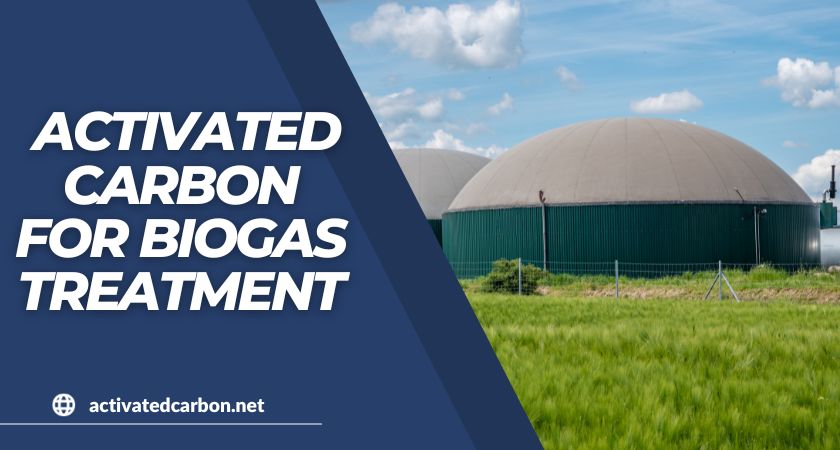
With the rapid development of the economy, the global energy demand is increasing. Excessive reliance on traditional fossil fuels in the energy structure can lead to a significant energy crisis. Biogas, as an emerging green energy source, is gaining attention and becoming prominent.
This article will delve into the role, advantages, and future development prospects of activated carbon in biogas desulfurization.
Biogas Desulfurization Technologies

Biogas is a mixed gas, primarily composed of methane (CH4), carbon dioxide (CO2), hydrogen sulfide (H2S), volatile organic compounds (VOCs), and nitrogen (N).
Hydrogen sulfide (H2S) in biogas can cause strong corrosion to metal equipment and pipes during usage, leading to the emission of harmful gases like sulfur dioxide, polluting the environment. Therefore, it is essential to remove hydrogen sulfide before comprehensive utilization.
Here are some common biogas desulfurization technologies.
Alkaline Liquid Absorption Method
Biogas enters the reaction tower from the bottom and contacts the absorbent liquid in countercurrent, and the purified biogas is discharged from the top of the tower. This desulfurization method, known as the alkaline liquid absorption method, utilizes oxygen to regenerate the absorbent.
PDS Method
In the PDS method, the reaction between sodium hydrosulfide, sodium bicarbonate, and elemental sulfur not only solves the problem of harmful substances generated by the reaction of sodium hydrosulfide with oxygen but also produces reaction products with higher sulfur capacity and larger sulfur particles, facilitating flotation and separation.
HPAS Oxidation-Air Regeneration Method
High polymeric compounds (HPC) can remove H2S from biogas and recycle the generated elemental sulfur. The HPAS method, with its excellent oxidation-reduction capability, converts H2S into elemental sulfur, consisting of desulfurization and oxidation-regeneration processes.
Iron Oxide Dry Desulfurization Method
Iron oxide, also known as sponge iron, is an ancient desulfurizing agent. The high oxidation-reduction potential of Fe3+ oxidizes H2S to elemental sulfur, which can be recycled. The generated elemental sulfur has a catalytic effect on the entire absorption process.
Activated Carbon Method
The activated carbon method consists of desulfurization and activated carbon regeneration processes. During desulfurization, activated carbon catalyzes hydrogen sulfide, reacts with the stored oxygen to produce elemental sulfur, and adsorbs it. When the activated carbon is saturated, it can be regenerated using ammonium sulfide solution, and the generated polysulfide ammonium undergoes steam heating to decompose into ammonium sulfide and elemental sulfur, continuing the cycle.
Membrane Separation Method
Membrane separation is a concentration-driven process. Due to the higher relative permeability of impurities such as CO2 and H2S compared to CH4, these impurities permeate to the low-pressure side to form permeate gas, while the CH4 gas in biogas becomes residual gas flowing out from the other side.
Activated Carbon for Biogas
While there are various biogas desulfurization technologies, many of them come with high costs and potential secondary pollution issues. Activated carbon, however, is a low-energy-consumption and low-pollution desulfurization technology that is gaining increasing attention.
Activated carbon, with its high surface area, adsorption rate, and capacity, achieves a desulfurization efficiency of up to 99%.
Its advantages include a fast reaction rate with hydrogen sulfide, short contact time, large processing capacity, and low desulfurization cost.
Do you plan to purchase activated carbon?
Applications

Activated carbon, by adsorbing impurities in biogas, can enhance the purity of biogas, thereby playing a more significant role in energy production and environmental protection. Below are some substances in biogas that activated carbon can adsorb.
Removal of Hydrogen Sulfide
Hydrogen sulfide is a colorless, flammable, and toxic gas harmful to both human health and the environment. Additionally, hydrogen sulfide is corrosive and can impact industrial equipment. Therefore, activated carbon is employed to remove it to avoid downstream operational issues.
Removal of VOCs
Volatile organic compounds (VOCs) are commonly present in biogas and can impact downstream processes if not promptly addressed. Activated carbon is effective in timely removing these volatile organic compounds.
Removal of Siloxanes
Siloxanes in biogas are organic polymers that can cause atmospheric pollution. When biogas containing siloxanes is burned, it produces silicon dioxide (SiO2), which deposits on biogas engines, affecting their performance and significantly shortening their lifespan.
Removal of Nitrogen
Nitrogen constitutes 78% of the atmosphere, and it is also present in biogas. Activated carbon materials are typically used for pressure swing adsorption (PSA) to preferentially adsorb CH4 over N2 before injecting into pipelines.
Adsorption of Carbon Dioxide
CO2, one of the greenhouse gases, usually comprises 20%-40% of biogas.
Selecting Right Activated Carbon

Coal Granular Activated Carbon
- Impregnated available
- Iodine Value: 600-1100 mg/g
- Mesh Size: 4×8, 8×16, 6×12, 8×16, 12×40 (more size on request)
- Apparenet Density: 450-550g/L
For biogas treatment, we recommend using activated carbon impregnated with potassium hydroxide (KOH) or potassium iodide (KI) for better purification results.
KOH can effectively adsorb hydrogen sulfide, converting it into non-volatile sulfides, significantly reducing environmental harm. KI can react with siloxanes, effectively adsorbing them to protect equipment from corrosion.
Do you plan to purchase activated carbon?
Final Thoughts
After reading the above content, you now have a more profound understanding of the methods and applications of activated carbon in biogas desulfurization.
Choosing the right activated carbon can maximize the purification effect of biogas, ensuring stability and reliability in its utilization.
Bamboo Forest Activated Carbon is an excellent activated carbon supplier and manufacturer in China with over 20 years of experience in the industry. Contact us for high-cost performance activated carbon that meets diverse needs.